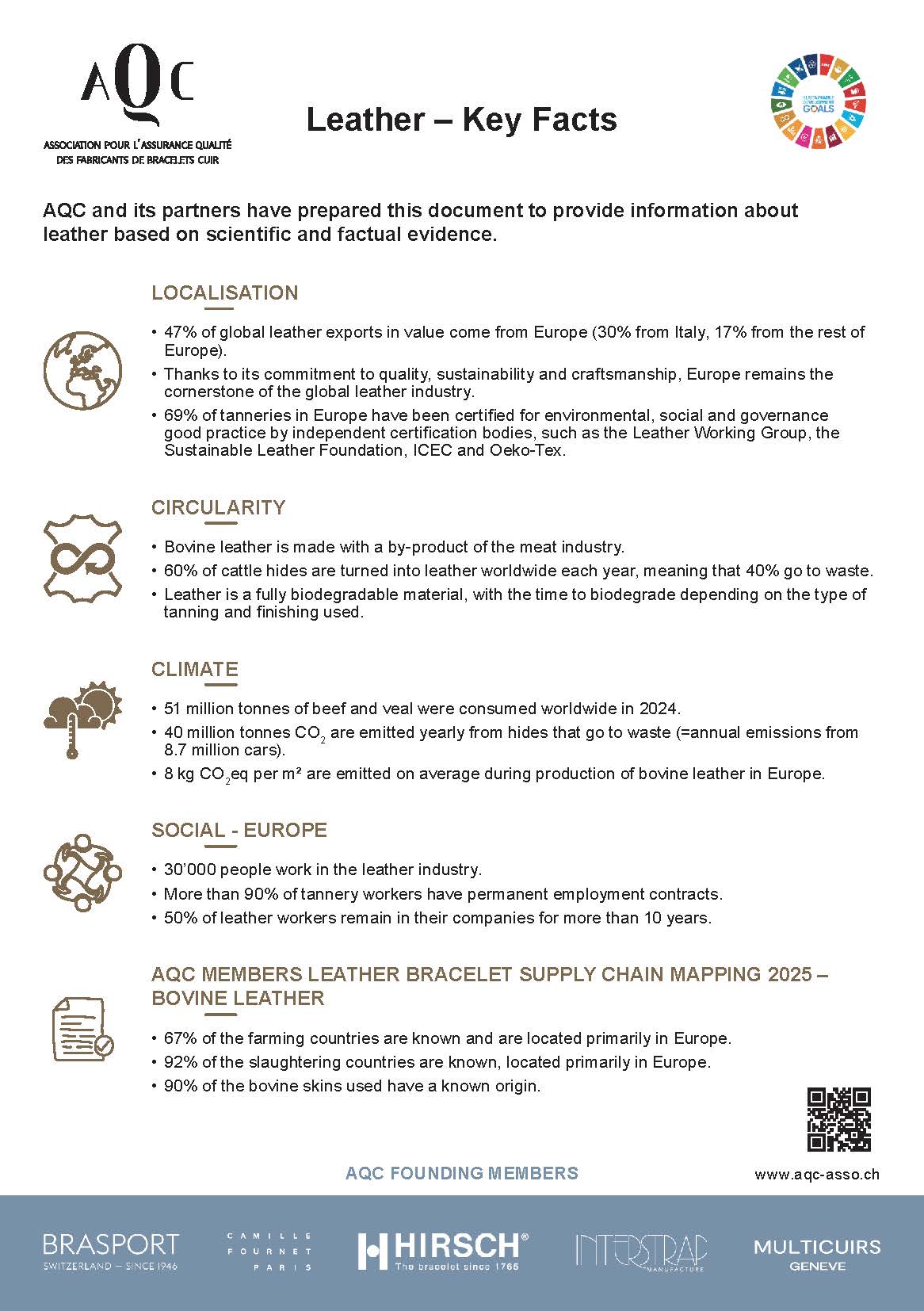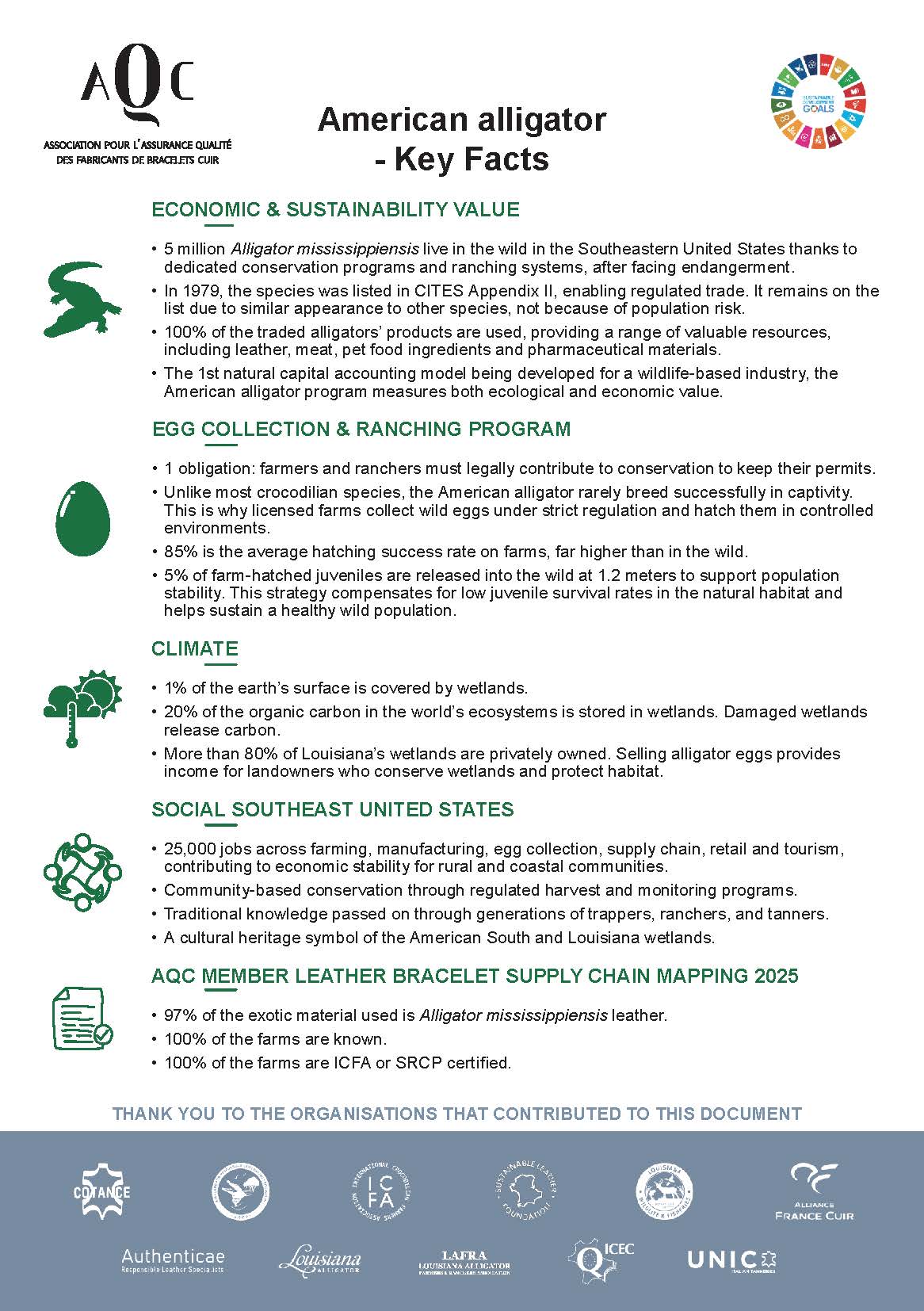Leather Key Facts


Media and Manifestos
In line with the AQC's mission, the content of our work is developed and shared transparently with all players in the watchmaking and leather sectors. Our main communication channels are the organisation of and participation in events, our
Here you can find articles that have been published, as well as the manifestos that AQC has signed over the past few years. To read them, simply click the links.
2025
- International Council of Tanners: "A Manifesto for Leather on the occasion of COP30: Leather and the Measure of What Matters"
- ILM: "SLF unites leaders with landmark crocodile sustainability study"
- World Leather: "AQC Advancing a responsible leather bracelet supply chain"
- ILM: "AQC Multistakeholder Meeting 2024"
- European Livestock Voice: "NLCA: The environmental impact of meat and dairy is half of what is calculated so far"
2024
- A&F PEFCR - Statement on Durability_Manifesto
- European Platform for Chemicals Using Manufacturing Industries_Manifesto
- The Guardian: "Trade can help protect species"
- The Luxury Journals: "Les fabricants de bracelets de montre en cuir s'unissent pour la durabilité"
- Swiss KnowHow: "Un soutien précieux dans la gestion de la conformité chimique des matériaux"
- ILM: "AQC presents laboratory working group results"
2023
- The Luxury Journals: "Quand cuir exotique rime avec éthique"
- The Luxury Journals: "When exotic leather means ethics"
- ILM: "Making chromium detection easier"
- Europa Star: "Leather Straps. When competitors become partners"
- Swiss KnowHow: "Un test rapide pour déceler la présence de Cr (VI)"
2022
2021
Alligator mississippiensis - Key Facts
AMERICAN ALLIGATOR
AQC members' crocodilian bracelets are crafted exclusively from Alligator mississippiensis, commonly known as the American alligator. The leather is sourced primarily from farms in Louisiana, as well as from Georgia, Texas, and Florida.
CITES
Convention on International Trade in Endangered Species of Wild Fauna and Flora
In 1979, Alligator mississippiensis was listed in Appendix II of the Convention on International Trade in Endangered Species of Wild Fauna and Flora (CITES), allowing its global trade under strict regulation. The species remains in Appendix II due to its close resemblance to other endangered or threatened crocodilian species.
Thanks to CITES' universal tagging requirement, the American alligator is part of the only wildlife group in the world for which individual identification tags are mandated from the point of harvest through to the final leather product. This system makes it the most traceable wildlife species globally, with every skin uniquely marked and monitored throughout the supply chain.
The AQC Members' supply chain mapping identifies each individual farm providing the alligator skins used for the bracelets. All of these farms—100%—are certified for animal welfare, primarily by the International Crocodilian Farmers Association (ICFA) and also by the Standard for Responsible Crocodilian Production (SRCP).
Both certifications ensure compliance with Chapter 7.14, Killing of reptiles for their skin, meat and other products, from the Terrestrial Animal Health Code of the World Organisation for Animal Health (WOAH).
5 MILLION IN THE WILD
Whereas in the 1960s American alligators were threatened by unregulated hunting, today their populations have fully recovered. According to the Louisiana Department of Wildlife and Fisheries (LDWF), the wild alligator population in Louisiana alone has grown to nearly three million in recent years. Florida, Georgia, Texas, and other Southeastern states report a combined wild population of over two million.
The USA, together with the United States Fish and Wildlife Service, strictly manage the American alligator as a renewable natural resource. Through science-based conservation measures—such as harvest quotas, habitat protection, and CITES regulations—populations are able to support sustainable use while remaining healthy and stable in the wild.
Scientists aim to demonstrate how alligator populations positively impact these ecosystems, fostering environments with rich biodiversity that lead to beneficial outcomes for nature. Link to article
EGGS COLLECTION
If the eggs were left in the wild, less than 10% would survive. Hurricanes and bad weather can flood the marshes and drown the eggs or young alligators. Many are also eaten by raccoons, snakes, and ants.
Farmers collect the eggs and keep them in safe, controlled conditions, where about 90% successfully hatch. The young alligators are raised until they are about four feet long. At that point, around 10% are released back into the wild. Alligators released at this size have a much better chance of surviving predators, which helps wild populations grow and stay strong.
ALLIGATOR MEAT
The American alligator is not only a resource for its skin, but also for its meat, which is sold widely across coastal regions in restaurants, supermarkets and sea food shops. The pet food industry uses other parts of the animal including the bones, and the pharmaceutical industry is currently testing and exploring uses of additional parts and by-products.
25’000 JOBS IN THE USA
The alligator industry supports approximately 25’000 jobs across the United States, spanning a wide range of sectors. These include land managers, biologists, veterinary professionals, farm workers, egg collectors, fishermen, meat processors, tanners, leather artisans, factory workers, transportation and logistics personnel, retail sales associates, and various industry suppliers.
The alligator industry generates $250 million in annual economic impact in Louisiana, supporting the livelihoods of rural communities and providing income in areas that often face significant economic challenges.
WETLANDS = CARBON SEQUESTRATION
More than 80% of Louisiana’s wetlands are privately owned. Hurricanes cause erosion and disrupt water flow, threatening these habitats. Farmers purchase alligator eggs from landowners, providing a direct financial incentive to maintain and restore the wetlands. Moreover, alligator farmers—who rely on the health of these ecosystems—actively contribute to restoration efforts, either independently or through partnerships with conservation organizations.
According to Science and the World Economic Forum, wetlands store 20% of the organic carbon in the world's ecosystems, despite covering only 1% of the earth's surface. ‘However, the capacity of wetlands to store carbon depends on feedbacks between vegetation and geomorphology that allow wetlands to continue to develop over long periods. When these feedbacks are interrupted, wetlands can become sources of carbon’.
IUCN
International Union for Conservation of Nature
IUCN letter to luxury CEOs: ‘The benefits that the trade in precious and exotic skins brings to nature and people, and to the adoption of the United Nations Sustainable Development Goals, are supported by scientific evidence. This trade is one of the great conservation success stories of our time. Species that were once close to extinction have recovered and are now the subject of meticulous management.' Link to letter
IUCN Redlist: Alligator mississippiensis: minor concern = neither endangered nor threatened.
THE END OF THE CALIFORNIA BAN
THE TRUTH ABOUT EXOTIC LEATHER: SUSTAINABILITY, CONSERVATION & ECONOMIC IMPACT
Christy Plott Gilmore & Karen Giberson, CFDA Article, March 2025
"Exotic leather is one of the most sustainable materials in fashion today. Unlike synthetic alternatives, exotic leather does not destroy habitats — it saves them. It ensures thriving ecosystems, protects endangered species, and empowers local communities who depend on these resources for survival." Read the article here
ICFA
The International Crocodilian Farmers’ Association (ICFA) is a not-for-profit association, created to develop and improve crocodilian farming practices; with respect for animal welfare, the environment, people and local communities. It is through this approach that farmers with common objectives are united.
Link to website here
ICFA REPORT: Download here
To read in the report:
- ICFA wants to demonstrate that it is possible to breed crocodilians in a way that respects the animals and animal welfare requirements.
- The farms were created in response to the risk of extinction of endangered wild animals in the 1970s.
- They are located in areas where crocodilians live, the bayous (wetlands). As the breeding model is based on collecting eggs from the wild, environmental protection is an obvious requirement.
- According to the Louisiana Department of Wildlife & Fisheries (LDWF), wetlands play a crucial role in combating global warming and preserving biodiversity.
- Carbon sequestration: They cover 1% of the oceans but provide 50% of marine carbon sequestration. One hectare of seagrass stores twice as much carbon as a forest.
- Biodiversity: In the United States, they are home to around 8'000 plant and animal species.
- Benefits of crocodilians: Meat rich in omega-3, low in fat, rich in fibre and protein. Their skin and medical applications (HIV, oncology, asthma, cosmetics).
- The social issue: 25'000 jobs in Louisiana in areas with difficult social situations.
SRCP
The SRCP - Standard for Responsible Crocodilian Production, is currently owned by the LVMH Group and was co-developed in 2018 with scientific experts and local stakeholders, including veterinarians, farmers, and standard setting organisations.
Managed by independent third parties, the SRCP has become a recognised standard against which alligator and crocodile farms supplying the LVMH-Group owned exotic leather tanneries are required to be certified.
This ensures that the farms supplying the Group and the exotic leather industry, including the watch bracelet sector, respect science-based animal welfare adapted to the species, its conservation, social responsibility on-farm and within the farms’ surrounding communities, biosecurity, and the environment.
Since 2020, 100% of the group-owned exotic tanneries procure crocodilian skins from SRCP certified farms.
Alligator Intelligence (AI)
AI brings together scientists, farmers, and environmentalists to spotlight alligators' role in sustainability. Backed by data, AI highlights their benefits to Louisiana’s ecosystems: Acreage Potential*, Carbon Sequestration, and Biodiversity.
Check the website here
Acreage Potential*: A concept that means how much new wetland area could be created using extra nutrients in the environment. Alligators help with this naturally—they release important nutrients like nitrogen and phosphorus, which support the growth of new land or slow down land loss. This is especially important in Louisiana, one of the biggest carbon storage areas in the world, which is shrinking because of climate change.
Bovine Leather
LEATHER IN EUROPE
COTANCE, LinkedIn, March 2025 :
Thanks to the Observatoire Économique de l’Alliance France Cuir & United Nations Comtrade, we now have an updated snapshot of the global leather industry—from raw material production to finished goods.
Key European Market Figures:
- Up to 30% of global leather exports come from Europe (Italy alone: 14.1%)
- Over 10% of global footwear exports (Italy: 10.7%, Germany: 4.1%, Belgium: 2.8%, Spain: 2.0%)
- Europe leads the luxury leather segment, with 37% of exports, surpassing China’s 31.8%
Per country:
Italy : 2nd largest (after China) global leather exporter (14.1%), contributing 22.8% of raw hides & skins exports, 24.5% of tanned leather, and 10.7% of footwear exports.
France : 4th largest exporter globally (6.4%) and a luxury market leader (position shared with Italy).
Germany : a major trade hub, ranking 3rd globally (after China & Vietnam) with 7.2% of leathergoods exports and 4.9% in apparel & accessories, importing heavily from Italy & Spain.
Spain : supplies 5.4% of global leather apparel & accessories, 4.1% of tanned leather, and 2.0% of footwear exports.
Belgium : strong in footwear exports (2.8%)
Netherlands : also key in footwear exports (2.1%) and raw hides trade (5.2%)
With its commitment to quality, sustainability, and craftsmanship, Europe remains the backbone of the global leather industry. Europe's strength lies in the strong partnerships along its supply and value chains.
WHEN HIDES ARE NOT USED
COTANCE, LinkedIn, November 2024:
"If skins are not turned into leather, they end up in landfill sites, where they rot naturally. Many people are unaware that the decomposition of animal matter produces greenhouse gases. Similarly, unwanted skins left to rot on landfill sites produce these emissions. Worldwide, up to 40% of cattle hides, or 134 million hides a year, are lost.
We in the leather industry know that this is a sad waste of natural and renewable resources and has a significant impact on the environment. However, the latest analysis by the LHCA (Leather and Hide Council of America) shows that the impact is much greater than previously thought. We had underestimated this figure by a factor of 8!
Using the ReFED impact calculator, the LHCA found that one tonne of hides in a landfill generates more than 13 tonnes of CO₂ equivalent. On a global scale, discarded hides thus contribute to more than 40 million tonnes of CO₂ equivalent emissions each year."
To put this into perspective:
- The equivalent of the annual emissions from 8.7 million cars.
- Comparable to the CO₂ absorbed by 660 million trees in 10 years.
- Comparable to feeding 5 million homes for a year.
But the story doesn't end here:
By processing the 334 million hides produced annually worldwide and sustainably storing the CO₂ in the leather, we could avoid some 100 million tonnes of CO₂e per year, generating just 13.3* million tonnes of CO₂e emissions (*using the average Eco2L/GreenDeal value for cattle leather).
In addition, all the leather grains and rinds produced could replace up to 3 billion m² of fossil fuel-based fashion materials, which also contribute to climate change. Turning hides into leather is part of the solution in the fight against climate change."
LEATHER BIODEGRADABILITY
COTANCE, Newsletter, January 2025:
"When produced using natural or biobased tanning agents and biodegradable additives, leather can decompose in industrial composting in as little as 20 days (as highlighted in Karl Flowers’ article, “Opportunities at Leather’s End-of-Life,” ILM, Sep-Oct 2024).
That’s a timeframe comparable to vegetable waste, which takes 5–30 days! This unique feature makes leather not only a valuable part of the circular economy, but also one of the most sustainable fashion materials."
HIGG MSI UPDATE
LWG, LinkedIn, October 2024:
"Leather Working Group (LWG) and Leather Naturally announce that a combined data submission by SPIN360 from their respective Life Cycle Assessment (LCA) studies has been adopted as the new average for bovine leather by the Higg Materials Sustainability Index (Higg MSI).
The new dataset, included in the October 2024 update of the Higg MSI, results in the environmental impacts of bovine leather being between 55% and 67% lower than the previous MSI value for leather. The global warming potential, which previously showed an impact of 36.8 points on the Higg MSI scale, is reduced by 60% to 14.6 points. This significant change helps to move things forward, promoting a more nuanced understanding of bovine leather as a sustainable material choice.
This global effort was led by SPIN360, which used data collected from 45 manufacturing plants in 18 countries and evaluated 92 leather products with the aim of providing a global representation of bovine leather. It covers the main end-use sectors for leather, including footwear, automotive, leather goods and furniture."
LEATHER TRACEABILITY CLUSTER
COTANCE, LinkedIn, February 2025:
“The Leather Traceability Cluster (LTC) has officially endorsed the essential traceability requirements developed by ICEC, Sustainable Leather Foundation, OEKO-TEX®, and Leather Working Group - a milestone in ensuring transparency and accountability in the leather supply chain.
This draft standard establishes common traceability requirements and verification elements, creating a tool for industry-wide certification. Following the formal voting procedure outlined in the LTC Terms of Reference (Section 5), it has now been adopted by the members of the Leather Traceability Cluster and will move forward through the fast-track CEN standardisation process.
Since its launch in 2022, the LTC has held 24 meetings, fostering unprecedented collaboration among industry stakeholders to align on minimum requirements for traceability and verification—paving the way for a stronger, more sustainable leather sector.”
AQC is a member of the Leather Traceability Cluster as a certification expert.
For alligator leather, traceability is ensured by the CITES tag.
More About Leather
Leather Naturally is the global voice of the leather industry. The organisation promotes responsibly produced leather and provides reliable information to consumers, designers and brands.
As a member of Leather Naturally, AQC shares a link to their fact sheets which answer key questions and provide an overview of the leather industry. Click here





